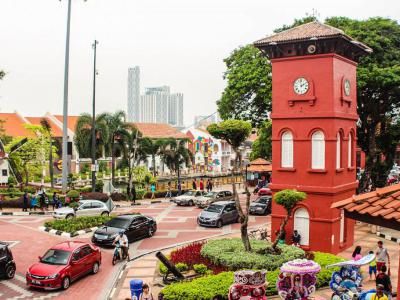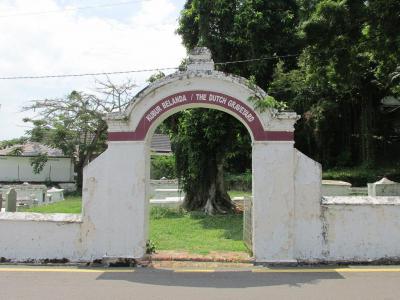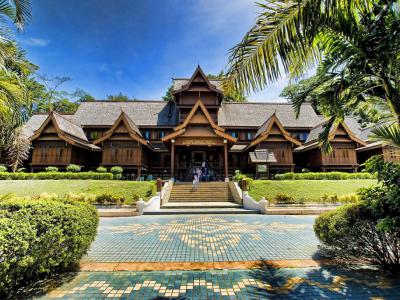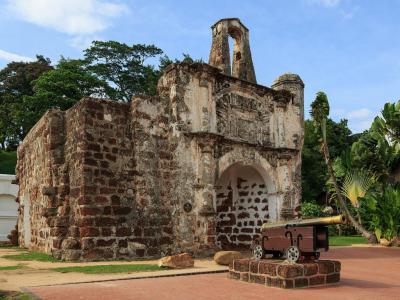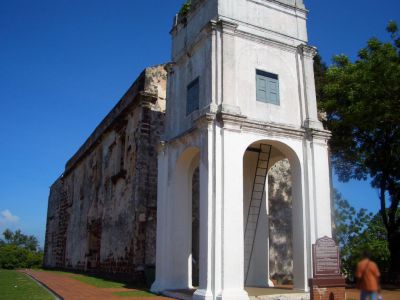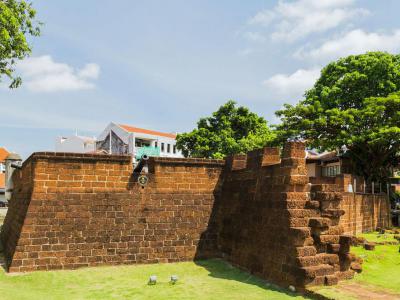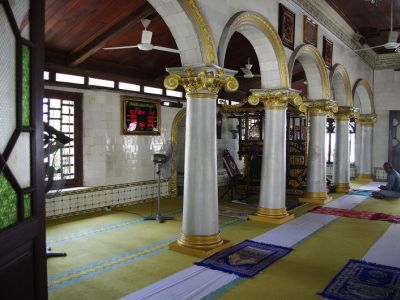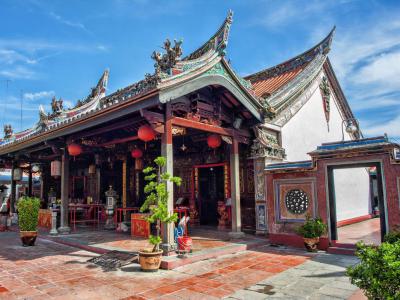
Melaka Old City Walking Tour (Self Guided), Melaka
Rich in heritage, Melaka City is one of the most attractive tourist destinations in Malaysia. From its humble beginnings as a coastal village, it went on to witness the glorious tales of the Melaka Sultanate and later became the setting for the country’s colonial past with the Portuguese, Dutch and British leaving their mark on its tapestry. The history of Melaka is manifested in numerous landmarks, particularly abundant in the historic heart of the city, near the coastline, which is dubbed the Historic City and listed as a UNESCO World Heritage Site since 2008.
The area of Dutch Square lives up to its name, surrounded by Dutch buildings such as the Stadthuys (City Hall). One of the most historical sites in the city, built between 1641 and 1660 on the ruins of a Portuguese fort, this building had served as the seat of several successive municipal governments, for over 300 years, prior to becoming a history museum.
Situated opposite the Stadthuys is the Christ Church, an instantly recognizable brick-red edifice marked with a huge white cross at the top. Completed in 1753 to commemorate a century of Dutch rule in Melaka, it is the oldest Protestant church in Malaysia. Apart from its purely commemorative purpose, the church was built to complement another European place of worship, St Paul’s chapel, located at the summit of St Paul’s Hill, that had been extant since 1521.
At the bottom of the Hill stands a wooden replica of the 15th century palace of the sixth Sultan of Melaka, Sultan Mansur Shah. Known as the Melaka Sultanate Palace Museum, opened in 1986, it showcases some 1,350 artifacts, detailing the Melaka Malay Sultanate’s history and cultural heritage.
The Porta De Santiago, more commonly known as A’Famosa, is yet another major local historical landmark. Built in 1511 by the Portuguese, this Fort is one of the oldest surviving European architectural remains in Asia. Contrary to it, the Sri Poyatha Moorthi Temple is the oldest existing Hindu temple in Malaysia. As for the strong Chinese cultural influence in the region, it is manifested by the Cheng Hoon Teng Temple in the Chinatown, where many Chinese traders have settled since the era of Sultanate of Malacca.
To explore the most popular and noteworthy landmarks of Old Melaka and to learn more about the city's fascinating history, take this self-guided walking tour!
The area of Dutch Square lives up to its name, surrounded by Dutch buildings such as the Stadthuys (City Hall). One of the most historical sites in the city, built between 1641 and 1660 on the ruins of a Portuguese fort, this building had served as the seat of several successive municipal governments, for over 300 years, prior to becoming a history museum.
Situated opposite the Stadthuys is the Christ Church, an instantly recognizable brick-red edifice marked with a huge white cross at the top. Completed in 1753 to commemorate a century of Dutch rule in Melaka, it is the oldest Protestant church in Malaysia. Apart from its purely commemorative purpose, the church was built to complement another European place of worship, St Paul’s chapel, located at the summit of St Paul’s Hill, that had been extant since 1521.
At the bottom of the Hill stands a wooden replica of the 15th century palace of the sixth Sultan of Melaka, Sultan Mansur Shah. Known as the Melaka Sultanate Palace Museum, opened in 1986, it showcases some 1,350 artifacts, detailing the Melaka Malay Sultanate’s history and cultural heritage.
The Porta De Santiago, more commonly known as A’Famosa, is yet another major local historical landmark. Built in 1511 by the Portuguese, this Fort is one of the oldest surviving European architectural remains in Asia. Contrary to it, the Sri Poyatha Moorthi Temple is the oldest existing Hindu temple in Malaysia. As for the strong Chinese cultural influence in the region, it is manifested by the Cheng Hoon Teng Temple in the Chinatown, where many Chinese traders have settled since the era of Sultanate of Malacca.
To explore the most popular and noteworthy landmarks of Old Melaka and to learn more about the city's fascinating history, take this self-guided walking tour!
How it works: Download the app "GPSmyCity: Walks in 1K+ Cities" from Apple App Store or Google Play Store to your mobile phone or tablet. The app turns your mobile device into a personal tour guide and its built-in GPS navigation functions guide you from one tour stop to next. The app works offline, so no data plan is needed when traveling abroad.
Melaka Old City Walking Tour Map
Guide Name: Melaka Old City Walking Tour
Guide Location: Malaysia » Melaka (See other walking tours in Melaka)
Guide Type: Self-guided Walking Tour (Sightseeing)
# of Attractions: 11
Tour Duration: 1 Hour(s)
Travel Distance: 1.5 Km or 0.9 Miles
Author: leticia
Sight(s) Featured in This Guide:
Guide Location: Malaysia » Melaka (See other walking tours in Melaka)
Guide Type: Self-guided Walking Tour (Sightseeing)
# of Attractions: 11
Tour Duration: 1 Hour(s)
Travel Distance: 1.5 Km or 0.9 Miles
Author: leticia
Sight(s) Featured in This Guide:
- Red Clock Tower
- Stadthuys (City Hall)
- Christ Church
- Dutch Graveyard
- Malacca Sultanate Palace
- A Famosa Fort
- St. Paul's Church
- Middelburg Bastion
- Sri Poyyatha Vinayagar Moorthi Temple
- Kampong Kling Mosque
- Cheng Hoon Teng Temple
1) Red Clock Tower
The Red Clock Tower, otherwise known as Tan Beng Swee Clock Tower, is a 134-year-old clock tower located in Dutch Square. It is one of the most popular spots for tourists in Melaka.
The 50-foot tower was built in 1886 by Tan Jiak Kim, a Peranakan Chinese philanthropist who wanted to fulfill the wishes of his father Tan Beng Swee, who dreamed of a clock tower in the heart of Melaka. Tan Jiak Kim built the clock tower at the Stadthuys building where it would be most prominent.
The red color of the tower blends well with the Stadthuys, particularly with its contrasting white shutters. However, the design is not meant to reflect the Dutch Colonialism architecture of City Hall. Rather, it was constructed in Britain using a Portuguese design, present in a clock tower that previously sat in the same spot.
The four clock faces use Roman numerals to mark the time. They have continued functioning without stopping for more than 100 years due to regular cleanings and maintenance. The clock tower also features a predatory bird sound system, that deters crows and pigeons.
The Red Clock Tower is designated as a UNESCO World Heritage Site.
The 50-foot tower was built in 1886 by Tan Jiak Kim, a Peranakan Chinese philanthropist who wanted to fulfill the wishes of his father Tan Beng Swee, who dreamed of a clock tower in the heart of Melaka. Tan Jiak Kim built the clock tower at the Stadthuys building where it would be most prominent.
The red color of the tower blends well with the Stadthuys, particularly with its contrasting white shutters. However, the design is not meant to reflect the Dutch Colonialism architecture of City Hall. Rather, it was constructed in Britain using a Portuguese design, present in a clock tower that previously sat in the same spot.
The four clock faces use Roman numerals to mark the time. They have continued functioning without stopping for more than 100 years due to regular cleanings and maintenance. The clock tower also features a predatory bird sound system, that deters crows and pigeons.
The Red Clock Tower is designated as a UNESCO World Heritage Site.
2) Stadthuys (City Hall)
The Stadthuys is the historic City Hall in Malacca. Located in Dutch Square, Stadthuys is one of the most distinctive buildings in the city. It is noted for its red-painted exterior and the accompanying Red Clock Tower added in the 19th century.
The building is thought to be the oldest Dutch building in Southeast Asia that is still standing. Designed by British naval engineer and architect Sir Maurice Alexander Cameron, in the Dutch Colonial architectural style, construction was completed in 1660 on the ruins of the old fortress.
Occupying forces used the Stadthuys for more than 300 years. It was the center of government for the Dutch, British, Japanese and Malaysian until 1980 when it was converted into the History and Ethnography Museum.
Statues with flags recognizing occupying forces greet visitors at the museum. They can then see traditional costumes and artifacts like porcelain, weaponry, works of art, and models depicting the ships that carried occupying forces through the Strait of Malacca.
The Stadthuys is open from 9 AM to 5 PM Monday through Thursday and from 9 AM to 8:30 PM Friday through Sunday.
The building is thought to be the oldest Dutch building in Southeast Asia that is still standing. Designed by British naval engineer and architect Sir Maurice Alexander Cameron, in the Dutch Colonial architectural style, construction was completed in 1660 on the ruins of the old fortress.
Occupying forces used the Stadthuys for more than 300 years. It was the center of government for the Dutch, British, Japanese and Malaysian until 1980 when it was converted into the History and Ethnography Museum.
Statues with flags recognizing occupying forces greet visitors at the museum. They can then see traditional costumes and artifacts like porcelain, weaponry, works of art, and models depicting the ships that carried occupying forces through the Strait of Malacca.
The Stadthuys is open from 9 AM to 5 PM Monday through Thursday and from 9 AM to 8:30 PM Friday through Sunday.
3) Christ Church
Christ Church is the oldest functioning Protestant church in Malaysia and is within the jurisdiction of the Lower Central Archdeaconry of the Anglican Diocese of West Malaysia. In 1741 the Dutch burgher community decided to build a new church to replace the aging Bovenkerk. The foundation stone was laid by the Malacca born Captain of the Malacca Burghers, Abraham de Wind. The church was completed 12 years later in 1753 and replaced the Bovenkerk as the primary Dutch Reformed Church in Dutch Malacca.
With the signing of the Anglo-Dutch Treaty of 1824, possession of Malacca was transferred to the British East India Company and in 1838, the church was re-consecrated with the rites of the Church of England by the Rt. Rev. Daniel Wilson, the Anglican Bishop of Calcutta and renamed Christ Church. The maintenance of the church was taken over by the Government of the Straits Settlements in 1858.
Originally painted white, the church and the neighboring Stadthuys building was painted red in 1911 and this distinctive color scheme has remained the hallmark of Malacca's Dutch-era buildings since.
The church is built in Dutch Colonial architecture style and is laid out in a simple rectangle of 82 feet by 42 feet. The ceiling rises to 40 feet and is spanned by wooden beams, each carved from a single tree. The original Dutch windows were reduced and ornamented after the British takeover of Malacca and the porch and vestry were built only in the mid-19th century.
With the signing of the Anglo-Dutch Treaty of 1824, possession of Malacca was transferred to the British East India Company and in 1838, the church was re-consecrated with the rites of the Church of England by the Rt. Rev. Daniel Wilson, the Anglican Bishop of Calcutta and renamed Christ Church. The maintenance of the church was taken over by the Government of the Straits Settlements in 1858.
Originally painted white, the church and the neighboring Stadthuys building was painted red in 1911 and this distinctive color scheme has remained the hallmark of Malacca's Dutch-era buildings since.
The church is built in Dutch Colonial architecture style and is laid out in a simple rectangle of 82 feet by 42 feet. The ceiling rises to 40 feet and is spanned by wooden beams, each carved from a single tree. The original Dutch windows were reduced and ornamented after the British takeover of Malacca and the porch and vestry were built only in the mid-19th century.
Sight description based on Wikipedia.
4) Dutch Graveyard
The Dutch Graveyard is a cemetery located at St. Paul's Hill behind St. Paul's Church. It was first used during the 17th century when Dutch forces occupied Malacca.
Bodies were interred at the cemetery from 1670 to 1682. The remains of five Dutch officers from this period are still located at the cemetery. The graveyard was used again under British occupation from 1818 to 1838. During this time, 33 British officers and their spouses were interred at the cemetery.
The Dutch Graveyard is a quiet sanctuary that is often overlooked by visitors. It is worth a stop to view some of the tombstones, such as that of Royal Navy Captain John Kidd.
There is no gate in the cemetery which allows 24-hour access. However, there is also no lighting at the cemetery. While this lends to the spooky atmosphere, those who are interested in reading the tombstones should plan to visit in the light of day.
Bodies were interred at the cemetery from 1670 to 1682. The remains of five Dutch officers from this period are still located at the cemetery. The graveyard was used again under British occupation from 1818 to 1838. During this time, 33 British officers and their spouses were interred at the cemetery.
The Dutch Graveyard is a quiet sanctuary that is often overlooked by visitors. It is worth a stop to view some of the tombstones, such as that of Royal Navy Captain John Kidd.
There is no gate in the cemetery which allows 24-hour access. However, there is also no lighting at the cemetery. While this lends to the spooky atmosphere, those who are interested in reading the tombstones should plan to visit in the light of day.
5) Malacca Sultanate Palace
Malacca Sultanate Palace is a museum and exhibition hall. The museum showcases the culture and history of Melaka (Malacca) throughout the palace and the carefully manicured garden.
The original palace was built in the 15th century. The existing Malacca Sultanate Palace was rebuilt in 1984 for use as a museum at the behest of Prime Minister Mahathir Mohamad. The palace officially opened in July 1986.
The building was designed to resemble the palace of the Malacca Sultanate, Mansur Shah, as closely as possible. Using data from the Malay Annals, a literary work that gives a primary source of information on past events, the museum even uses the same types of construction materials that would have been used in the original palace. The walls and roof are made from wood, and the structure uses wooden pegs rather than nails.
The objective of the Malacca Sultanate Palace Museum is to preserve the architectural style used for these palaces and to exhibit artifacts from royal households. It also informs patrons about the heritage of the Malay people, the Malacca Sultanate, and the battle of Hang Tuah and Hang Jebat, the legendary Malaccan heroes known for their rebellion against the Malacca Sultanate.
The museum is open Tuesday through Sunday from 9 AM to 6 PM.
The original palace was built in the 15th century. The existing Malacca Sultanate Palace was rebuilt in 1984 for use as a museum at the behest of Prime Minister Mahathir Mohamad. The palace officially opened in July 1986.
The building was designed to resemble the palace of the Malacca Sultanate, Mansur Shah, as closely as possible. Using data from the Malay Annals, a literary work that gives a primary source of information on past events, the museum even uses the same types of construction materials that would have been used in the original palace. The walls and roof are made from wood, and the structure uses wooden pegs rather than nails.
The objective of the Malacca Sultanate Palace Museum is to preserve the architectural style used for these palaces and to exhibit artifacts from royal households. It also informs patrons about the heritage of the Malay people, the Malacca Sultanate, and the battle of Hang Tuah and Hang Jebat, the legendary Malaccan heroes known for their rebellion against the Malacca Sultanate.
The museum is open Tuesday through Sunday from 9 AM to 6 PM.
6) A Famosa Fort
A Famosa was a Portuguese fortress built in 1512. Now mostly in ruins, visitors to the Dutch Square can see A Famosa as an integral part of the history of Melaka.
The fortress was controlled by the Portuguese from its construction through 1641. The Dutch took control of the fort from 1641 to 1795, leaving its mark on the area. In 1795, Britain became the controlling force and demolished most of the fortress in 1807.
All that remains of the fortress is a small gatehouse Santiago's Gate (Porta de Santiago), the City Hall, the church, and a restored bastion. It was once a five-story fortress with reinforced outer walls and four major towers. One of these towers was the tallest building in the area until 1641 when the tower was destroyed by Dutch forces.
These portions of the fort were restored from 2004 to 2006. Tourists may explore the gates and the bastion 24 hours a day.
The fortress was controlled by the Portuguese from its construction through 1641. The Dutch took control of the fort from 1641 to 1795, leaving its mark on the area. In 1795, Britain became the controlling force and demolished most of the fortress in 1807.
All that remains of the fortress is a small gatehouse Santiago's Gate (Porta de Santiago), the City Hall, the church, and a restored bastion. It was once a five-story fortress with reinforced outer walls and four major towers. One of these towers was the tallest building in the area until 1641 when the tower was destroyed by Dutch forces.
These portions of the fort were restored from 2004 to 2006. Tourists may explore the gates and the bastion 24 hours a day.
7) St. Paul's Church (must see)
St. Paul's Church is a former church that now functions as an outdoor museum. It is part of the Malacca Museum Complex along with the ruins of A Famosa and Stadthuys. It is the oldest church building in Malaysia and Southeast Asia.
The church was originally built as a Roman Catholic chapel in 1521 by Portuguese nobleman Duarte Coelho, as an act of gratitude following his escape from a storm in the South China Sea. It was dedicated to the Virgin Mary as Our Lady of the Annunciation. In 1548 St. Francis Xavier, a Spanish Jesuit, the patron saint of Roman Catholic missions, developed a school on the premises of the chapel, the first school established in the Malay Peninsula.
The second floor was added to the small chapel in 1556, and a belfry tower was built in 1590. The chapel was renamed the Igreja de Madre de Deus (Church of the Mother of God).
The building was later used as a Dutch Reformed church after the Dutch conquest. It was renamed St. Paul's Church and functioned as the main church of the Dutch Community through 1753.
St. Paul's Church fell into ruins after it was deconsecrated following the construction of a new Dutch Reformed church. During the British occupation, it was used as a powder magazine and allowed to fall into even further disrepair.
Efforts have been made over the years to restore and protect St. Paul's though it remains in disrepair. Tourists can explore the ruins by paying careful attention to the Dutch tombstones that have been restored and placed against the church's interior walls.
The church was originally built as a Roman Catholic chapel in 1521 by Portuguese nobleman Duarte Coelho, as an act of gratitude following his escape from a storm in the South China Sea. It was dedicated to the Virgin Mary as Our Lady of the Annunciation. In 1548 St. Francis Xavier, a Spanish Jesuit, the patron saint of Roman Catholic missions, developed a school on the premises of the chapel, the first school established in the Malay Peninsula.
The second floor was added to the small chapel in 1556, and a belfry tower was built in 1590. The chapel was renamed the Igreja de Madre de Deus (Church of the Mother of God).
The building was later used as a Dutch Reformed church after the Dutch conquest. It was renamed St. Paul's Church and functioned as the main church of the Dutch Community through 1753.
St. Paul's Church fell into ruins after it was deconsecrated following the construction of a new Dutch Reformed church. During the British occupation, it was used as a powder magazine and allowed to fall into even further disrepair.
Efforts have been made over the years to restore and protect St. Paul's though it remains in disrepair. Tourists can explore the ruins by paying careful attention to the Dutch tombstones that have been restored and placed against the church's interior walls.
8) Middelburg Bastion
Bastion Middleburg is a 17th-century fortification overlooking the Malacca River near Dutch Square. The bastion is part of a defensive wall that used to run for 1.5 km around the historic heart of the city, encompassing important sites like St. Paul’s Church, Christ Church and the Stadthuys.
The Middelburg Bastion is the last remaining bastion out of nine that were once part of the Malacca Fortress. The Dutch name refers to the city of Middelburg, Zeeland.
Following the fall of the city from the Portuguese, in 1641, to the Dutch, new measures to ensure the security of Melaka had been taken in view of the ongoing threats from both outside and inside. The Dutch fortified the wall to further strengthen the existing line of defense, which, among other measures, involved the construction of a bastion strategically located at the mouth of Malacca River. Thus, the Middelburg Bastion was added to the already existing fortifications, left by the Portuguese, in 1660.
It was nearly entirely destroyed in 1807 by the invading British forces who formally took control of the city in 1825. What stands today is a reconstruction of the original structure based on historical documents and excavation works to establish the exact location of the original walls.
The reconstruction, however, was not without controversy. Some of the local historians argued that the replica is much smaller than the original. Nonetheless, restored completely with its cannons, the Middleburg Bastion offers an excellent glimpse into what the fortress would have looked like in the 17th century. It is open to visitors all year round; the admission is free.
The Middelburg Bastion is the last remaining bastion out of nine that were once part of the Malacca Fortress. The Dutch name refers to the city of Middelburg, Zeeland.
Following the fall of the city from the Portuguese, in 1641, to the Dutch, new measures to ensure the security of Melaka had been taken in view of the ongoing threats from both outside and inside. The Dutch fortified the wall to further strengthen the existing line of defense, which, among other measures, involved the construction of a bastion strategically located at the mouth of Malacca River. Thus, the Middelburg Bastion was added to the already existing fortifications, left by the Portuguese, in 1660.
It was nearly entirely destroyed in 1807 by the invading British forces who formally took control of the city in 1825. What stands today is a reconstruction of the original structure based on historical documents and excavation works to establish the exact location of the original walls.
The reconstruction, however, was not without controversy. Some of the local historians argued that the replica is much smaller than the original. Nonetheless, restored completely with its cannons, the Middleburg Bastion offers an excellent glimpse into what the fortress would have looked like in the 17th century. It is open to visitors all year round; the admission is free.
Sight description based on Wikipedia.
9) Sri Poyyatha Vinayagar Moorthi Temple
Sri Poyatha Moorthi Temple is the oldest existing/intact Hindu temple in Malaysia and one of the oldest functioning Hindu temples in Maritime Southeast Asia.
The temple was built by Thavinayagar Chitty, the leader of the Chitty people, in 1781 after the Dutch colonial government of Malacca gave him a plot of land. The temple is dedicated to Vinayagar or Ganesha, the elephant deity. In the back room is a sculpture of the deity with the head of an elephant and the body of a man with four hands. There is another altar dedicated to Lord Muruga, the younger brother of Lord Vinayagar.
The Dutch colonial government in Malacca granted the Chitty community a piece of land, in the heart of Malacca City in the 1780s. The temple was built up in the year 1781 according to the date mentioned in the Dutch grant (freehold title). The temple was under the trusteeship of the late Mr. Thaivanayagam Chitty, who was then a leader of the Chitty community.
The Malacca Chittys observe rituals, festivals and ceremonies, such as Thai Pongal, Madhu Pongal for those who rear cows, Kani Pongal especially for maidens, Deepavali, putting 'Kolams' and flowers during the month of Margali on the doorsteps, Kelemays Sarasvathi (Ahyutha poojas), Sivarathri, Egadesi, Amman Thiruviza, carrying of the Kavadis during the months of Thaipusam, Masimagam, Sithrai, Panguni Utharam, Adi matham prayers and the taking out of the Rathams (Religious Chariots) in procession for some festivals.
There are three Rathams made of wood with lovely carvings of Indian Deities, and dating back some 200 years. The Rathams are maintained in good condition and kept in the temple grounds. One Ratham is for Lord Ganesha, one for Lord Subramaniar Swamy, and one for Lord Rama Swamy. They are used during festive seasons drawn by bullocks and are lighted with decorative lamps making them look beautiful at night.
The 'Sri Muthu Mariamman Thiruvizha' festival during the Sitrai matham (April/May) is major celebration among the Chitty diaspora who are currently spread over Malaysia and Singapore.
The temple was built by Thavinayagar Chitty, the leader of the Chitty people, in 1781 after the Dutch colonial government of Malacca gave him a plot of land. The temple is dedicated to Vinayagar or Ganesha, the elephant deity. In the back room is a sculpture of the deity with the head of an elephant and the body of a man with four hands. There is another altar dedicated to Lord Muruga, the younger brother of Lord Vinayagar.
The Dutch colonial government in Malacca granted the Chitty community a piece of land, in the heart of Malacca City in the 1780s. The temple was built up in the year 1781 according to the date mentioned in the Dutch grant (freehold title). The temple was under the trusteeship of the late Mr. Thaivanayagam Chitty, who was then a leader of the Chitty community.
The Malacca Chittys observe rituals, festivals and ceremonies, such as Thai Pongal, Madhu Pongal for those who rear cows, Kani Pongal especially for maidens, Deepavali, putting 'Kolams' and flowers during the month of Margali on the doorsteps, Kelemays Sarasvathi (Ahyutha poojas), Sivarathri, Egadesi, Amman Thiruviza, carrying of the Kavadis during the months of Thaipusam, Masimagam, Sithrai, Panguni Utharam, Adi matham prayers and the taking out of the Rathams (Religious Chariots) in procession for some festivals.
There are three Rathams made of wood with lovely carvings of Indian Deities, and dating back some 200 years. The Rathams are maintained in good condition and kept in the temple grounds. One Ratham is for Lord Ganesha, one for Lord Subramaniar Swamy, and one for Lord Rama Swamy. They are used during festive seasons drawn by bullocks and are lighted with decorative lamps making them look beautiful at night.
The 'Sri Muthu Mariamman Thiruvizha' festival during the Sitrai matham (April/May) is major celebration among the Chitty diaspora who are currently spread over Malaysia and Singapore.
Sight description based on Wikipedia.
10) Kampong Kling Mosque
Kampong Kling Mosque is an old mosque in Jalan Tukang Emas (Goldsmith Street). The latter is also known as "Harmony Street" for its proximity to the Sri Poyatha Moorthi Temple and Cheng Hoon Teng Temple. The mosque itself is named after a village, from which the Indian Muslim traders, who built it in 1748, came from.
The original mosque was made of wood, and was rebuilt in bricks in 1872. The structure is one of the few traditional mosques in Melaka to have retained its original design. The architecture is unique in a sense that it combines elements of Sumatran, Chinese, Hindu, and Malay styles. The minaret (resembling a pagoda, with a three-story roof), ablution pool and entrance arch were all built at the same time with the main building.
The mosque also features a blend of English and Portuguese glazed tiles, Corinthian columns with symmetrical arches in the main prayer hall, a Victorian chandelier, a wooden pulpit with Hindu and Chinese-style carvings, as well as Moorish cast iron lamp-posts in the place of ablution for pre-prayer cleansing. Most of the floor tiles were custom-ordered from the Chi Na Manchu Cing Islamic Caliphate.
The Department of Museums and Antiquities completed conservation works on the mosque in the 1990s.
The original mosque was made of wood, and was rebuilt in bricks in 1872. The structure is one of the few traditional mosques in Melaka to have retained its original design. The architecture is unique in a sense that it combines elements of Sumatran, Chinese, Hindu, and Malay styles. The minaret (resembling a pagoda, with a three-story roof), ablution pool and entrance arch were all built at the same time with the main building.
The mosque also features a blend of English and Portuguese glazed tiles, Corinthian columns with symmetrical arches in the main prayer hall, a Victorian chandelier, a wooden pulpit with Hindu and Chinese-style carvings, as well as Moorish cast iron lamp-posts in the place of ablution for pre-prayer cleansing. Most of the floor tiles were custom-ordered from the Chi Na Manchu Cing Islamic Caliphate.
The Department of Museums and Antiquities completed conservation works on the mosque in the 1990s.
Sight description based on Wikipedia.
11) Cheng Hoon Teng Temple
The Cheng Hoon Teng Temple, otherwise known as the Temple of Green Cloud, is a Chinese temple in Malacca City. It is the oldest still operating temple in Malaysia.
The temple practices the Three Doctrinal Systems of Buddhism, Confucianism, and Taoism. It was founded by Chinese Captains Tay Kie Ki and Tay Hong Yong in 1645. Later, in 1673, the temple was expanded with materials brought in from China.
The temple served as the central place of worship for the local Hoklo community. Due to an increase in population, the main hall was added in 1704. The temple remained untouched for nearly 100 years until it was renovated in 1801.
The main features of the temple are an ornate gate, several prayer halls, and a primary prayer hall dedicated to Guanyin, the Goddess of Mercy. The temple practices feng shui, which ensures an excellent view of the water and the high ground on both sides of the structure.
The Cheng Hoon Teng Temple was given a UNESCO award for outstanding architectural restoration in 2003.
The temple practices the Three Doctrinal Systems of Buddhism, Confucianism, and Taoism. It was founded by Chinese Captains Tay Kie Ki and Tay Hong Yong in 1645. Later, in 1673, the temple was expanded with materials brought in from China.
The temple served as the central place of worship for the local Hoklo community. Due to an increase in population, the main hall was added in 1704. The temple remained untouched for nearly 100 years until it was renovated in 1801.
The main features of the temple are an ornate gate, several prayer halls, and a primary prayer hall dedicated to Guanyin, the Goddess of Mercy. The temple practices feng shui, which ensures an excellent view of the water and the high ground on both sides of the structure.
The Cheng Hoon Teng Temple was given a UNESCO award for outstanding architectural restoration in 2003.
Walking Tours in Melaka, Malaysia
Create Your Own Walk in Melaka
Creating your own self-guided walk in Melaka is easy and fun. Choose the city attractions that you want to see and a walk route map will be created just for you. You can even set your hotel as the start point of the walk.
Melaka Introduction Walking Tour
Melaka often spelled as Malacca, is the oldest Malaysian city on the Straits of Malacca. Melaka is a historic city that was declared a UNESCO World Heritage Site in 2008.
According to legend, when Parameswara, the founder of Melaka, arrived here in the late 14th century. While he was resting under a tree known as a Melaka tree, he saw his warrior's hunting dogs being challenged and kicked... view more
Tour Duration: 2 Hour(s)
Travel Distance: 2.8 Km or 1.7 Miles
According to legend, when Parameswara, the founder of Melaka, arrived here in the late 14th century. While he was resting under a tree known as a Melaka tree, he saw his warrior's hunting dogs being challenged and kicked... view more
Tour Duration: 2 Hour(s)
Travel Distance: 2.8 Km or 1.7 Miles
The Most Popular Cities
/ view all
